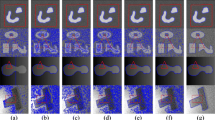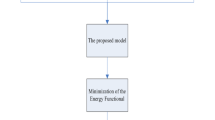Abstract
In order to better handle images with intensity inhomogeneity and noise, an adaptive multi-level set active contour model based on block search is proposed in this paper. This model first defines a multiple edge extension criterion for the input image to block the image and avoid the loss of image edge information; Then, the proposed adaptive block search method is used to find the level set that is considered redundant, and the remaining parts are fused to obtain a rough binary mask; Finally, the target is extracted by using the newly defined energy functional and the edge contours of the extracted binary mask. The experimental results show that the average jaccard similarity coefficients of the proposed model for segmenting images with intensity inhomogeneity and real images are 97.81% and 98.41%, respectively, and the accuracy of the segmentation results is higher than that of other models participating in the comparison. Similarly, the results of the ablation experiment once again validated the robustness of the proposed model.












Similar content being viewed by others
Data Availability
Data sharing not applicable to this article as no datasets were generated or analyzed during the current study.
References
Subudhi P, Mukhopadhyay S (2021) A statistical active contour model for interactive clutter image segmentation using graph cut optimization. Signal Process 4:108056
Bin H, Yiquan W (2019) Active contours driven by global and local weighted signed pressure force for image segmentation. Pattern Recogn 88:715–728
Fang L, Zhang L, Yao Y, Chen L (2021) Ultrasound image segmentation using an active contour model and learning-structured inference. Multimed Tools Appl 8
Li Y, Wang Z (2020) A medical image segmentation method based on hybrid active contour model with global and local features. Concurr Comput Pract Exp 32(19)
Zhu S, Bu X, Zhou Q (2018) A novel edge preserving active contour model using guided filter and harmonic surface function for infrared image segmentation. IEEE Access 6(99):5493–5510
Liu G, Jiang Y, Chang B, Liu D (2022) Superpixel-based active contour model via a local similarity factor and saliency. Measurement 188:110442
Liu G, Jiang Y, Liu D, Chang B, Ru L, Li M (2023) A coarse-to-fine segmentation frame for polyp segmentation via deep and classification features. Expert Syst Appl
Belgrana FZ, Benamrane N, Kasmi SA (2020) A hybrid segmentation approach of brain magnetic resonance imaging using region-based active contour with a similarity factor and multi-population genetic algorithm. Pattern Recognit Image Anal 30(4):765–777
Saman S, Narayanan SJ (2021) Active contour model driven by optimized energy functionals for mr brain tumor segmentation with intensity inhomogeneity correction. Multimed Tools Appl 80(14):21925–21954
Bampis CG, Maragos P, Bovik AC (2017) Graph-driven diffusion and random walk schemes for image segmentation. IEEE Trans Image Process 26(1):35–50
Zhou Y, Shi WR, Chen W, Chen YL, Li Y, Tan LW, Chen DQ (2015) Active contours driven by localizing region and edge-based intensity fitting energy with application to segmentation of the left ventricle in cardiac ct images. Neurocomputing 156((may 25)):199–210
Kass M, Witkin A, Terzopoulos D (1988) Snakes: active contour models. IJCV 1(4):321–331
Caselles V, Kimmel R, Sapiro G (1997) Geodesic active contour. Int J Comput Vis 22(1):61–79
Paragios N, Deriche R (2000) Geodesic active contours and level sets for the detection and tracking of moving objects. IEEE Trans Pattern Anal Mach Intell 22(3):266–280
Li C, Xu C, Gui C, Fox MD (2005) Level set evolution without re-initialization: a new variational formulation. Proceedings of the IEEE International Conference on Computer Vision and Pattern Recognition. pp 430–436
Li C, Xu C, Gui C, Fox MD (2010) Distance regularized level set evolution and its application to image segmentation. IEEE Trans Image Process 19(12):3243–3254
Chan Tony F, Vese Luminita A (2001) Active contours without edges. IEEE Trans Image Process 266–277
Li C, Kao CY, Gore JC, Ding Z (2007) Implicit active contours driven by local binary fitting energy. In: Computer vision and pattern recognition
Li C, Kao CY, Gore JC, Ding Z (2008) Minimization of region-scalable fitting energy for image segmentation. IEEE Trans Image Process 10:1940–1949
Vese LA, Chan TF (2002) A multiphase level set framework for image segmentation using the mumford and shah model. Int J Comput Vision 50(3):271–293
Dai L, Ding J, Yang J (2015) Inhomogeneity-embedded active contour for natural image segmentation. Pattern Recognit 48(8):2513–2529
Zhang K, Liu Q, Song H, Li X (2015) A variational approach to simultaneous image segmentation and bias correction. IEEE Trans Cybern 45(8):1426–1437
Wang G, Dong Q, Pan Z, Zhang W, Duan J, Bai L, Zhang J (2016) Retinex theory based active contour model for segmentation of inhomogeneous images. Digit Signal Process 50(C):43–50
Shan X, Gong X, Ren Y, Nandi AK (2020) Image segmentation using an active contour model based on the difference between local intensity averages and actual image intensities. IEEE Access 8:43200–43214
Peng Y, Liu S, Qiang Y, Wu XJ, Hong L (2019) A local mean and variance active contour model for biomedical image segmentation. J Comput Sci 33(APR.):11–19
Xiao L, Ding K, Geng J, Rao X (2018) Active contours driven by grayscale morphology fitting energy for fast image segmentation. J Electron Imaging 27(6):1
Deng M, Zhou Z, Liu G, Zeng D, Zhang M (2023) Adaptive active contour model based on local bias field estimation and saliency. J Intell Fuzzy Syst 45(6):11269–11283
Zhi X-H, Shen H-B (2018) Saliency driven region-edge-based top down level set evolution reveals the asynchronous focus in image segmentation. Pattern Recogn 241–255
Zhang K, Song H, Zhang L (2010) Active contours driven by local image fitting energy. Pattern Recogn 43(4):1199–1206
Zhang K, Zhang L, Lam KM, Zhang D (2016) A level set approach to image segmentation with intensity inhomogeneity. IEEE Trans Cybern 46(2):546–557
Weng G, Dong B, Lei Y (2021) A level set method based on additive bias correction for image segmentation. Expert Syst Appl (185–Dec.)
Mumford D, Shah J (1989) Optimal approximations by piecewise smooth functions and associated variational problems. Commun Pure Appl Math 42(5):577–685
Osher S, Sethian JA (1988) Fronts propagating with curvature-dependent speed: Algorithms based on hamilton-jacobi formulations. J Comput Phys 79(1):12–49
Shu X, Yang Y, Wu B (2021) A neighbor level set framework minimized with the split bregman method for medical image segmentation. Signal Process
Fang J, Liu H, Liu J, Zhou H, Liu H (2021) Fuzzy region-based active contour driven by global and local fitting energy for image segmentation. Appl Soft Comput 100:106982
Soomro S, Munir A, Choi KN (2019) Fuzzy c-means clustering based active contour model driven by edge scaled region information - sciencedirect. Expert Syst Appl 120(15):387–396
Everingham M, Van Gool L, Williams C, Winn J, Zisserman A (2010) The pascal visual object classes (voc) challenge. Int J Comput Vis 2:88
Acknowledgements
The work is supported by the National Key Research and Development Program of China (2022YFF0607001), Guangdong Basic and Applied Basic Research Foundation (2023A1515010993), Guangdong Provincial Key Laboratory of Human Digital Twin (2022B1212010004), Guangzhou City Science and Technology Research Projects (2023B01J0011), Jiangmen Science and Technology Research Projects (2021080200070009151), Shaoguan Science and Technology Research Project (230316116276286), Foshan Science and Technology Research Project(2220001018608).
Author information
Authors and Affiliations
Corresponding author
Ethics declarations
Conflicts of interest
We declared there is no conflict of interest in terms with this submission.
Additional information
Publisher's Note
Springer Nature remains neutral with regard to jurisdictional claims in published maps and institutional affiliations.
Appendix A
Appendix A
Rights and permissions
Springer Nature or its licensor (e.g. a society or other partner) holds exclusive rights to this article under a publishing agreement with the author(s) or other rightsholder(s); author self-archiving of the accepted manuscript version of this article is solely governed by the terms of such publishing agreement and applicable law.
About this article
Cite this article
Zhou, Z., Deng, M., Liu, G. et al. An adaptive multi-level-sets active contour model based on block search. Multimed Tools Appl 83, 72371–72390 (2024). https://doi.org/10.1007/s11042-024-18465-9
Received:
Revised:
Accepted:
Published:
Issue Date:
DOI: https://doi.org/10.1007/s11042-024-18465-9




